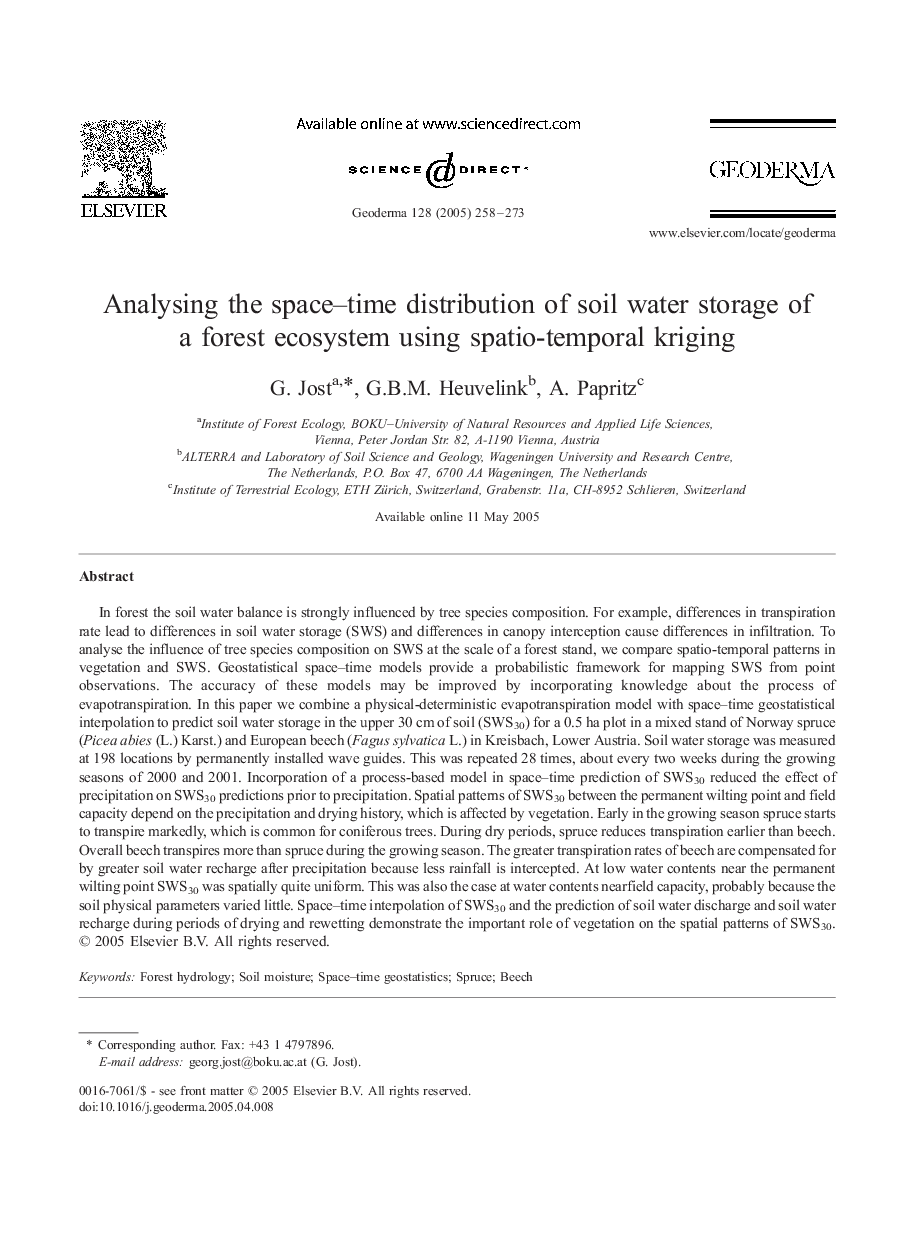| کد مقاله | کد نشریه | سال انتشار | مقاله انگلیسی | نسخه تمام متن |
|---|---|---|---|---|
| 9490428 | 1629575 | 2005 | 16 صفحه PDF | دانلود رایگان |
عنوان انگلیسی مقاله ISI
Analysing the space-time distribution of soil water storage of a forest ecosystem using spatio-temporal kriging
دانلود مقاله + سفارش ترجمه
دانلود مقاله ISI انگلیسی
رایگان برای ایرانیان
موضوعات مرتبط
مهندسی و علوم پایه
علوم زمین و سیارات
فرآیندهای سطح زمین
پیش نمایش صفحه اول مقاله

چکیده انگلیسی
In forest the soil water balance is strongly influenced by tree species composition. For example, differences in transpiration rate lead to differences in soil water storage (SWS) and differences in canopy interception cause differences in infiltration. To analyse the influence of tree species composition on SWS at the scale of a forest stand, we compare spatio-temporal patterns in vegetation and SWS. Geostatistical space-time models provide a probabilistic framework for mapping SWS from point observations. The accuracy of these models may be improved by incorporating knowledge about the process of evapotranspiration. In this paper we combine a physical-deterministic evapotranspiration model with space-time geostatistical interpolation to predict soil water storage in the upper 30 cm of soil (SWS30) for a 0.5 ha plot in a mixed stand of Norway spruce (Picea abies (L.) Karst.) and European beech (Fagus sylvatica L.) in Kreisbach, Lower Austria. Soil water storage was measured at 198 locations by permanently installed wave guides. This was repeated 28 times, about every two weeks during the growing seasons of 2000 and 2001. Incorporation of a process-based model in space-time prediction of SWS30 reduced the effect of precipitation on SWS30 predictions prior to precipitation. Spatial patterns of SWS30 between the permanent wilting point and field capacity depend on the precipitation and drying history, which is affected by vegetation. Early in the growing season spruce starts to transpire markedly, which is common for coniferous trees. During dry periods, spruce reduces transpiration earlier than beech. Overall beech transpires more than spruce during the growing season. The greater transpiration rates of beech are compensated for by greater soil water recharge after precipitation because less rainfall is intercepted. At low water contents near the permanent wilting point SWS30 was spatially quite uniform. This was also the case at water contents nearfield capacity, probably because the soil physical parameters varied little. Space-time interpolation of SWS30 and the prediction of soil water discharge and soil water recharge during periods of drying and rewetting demonstrate the important role of vegetation on the spatial patterns of SWS30.
ناشر
Database: Elsevier - ScienceDirect (ساینس دایرکت)
Journal: Geoderma - Volume 128, Issues 3â4, October 2005, Pages 258-273
Journal: Geoderma - Volume 128, Issues 3â4, October 2005, Pages 258-273
نویسندگان
G. Jost, G.B.M. Heuvelink, A. Papritz,